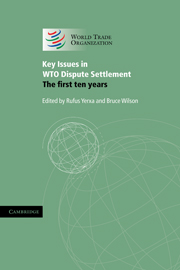Book contents
- Frontmatter
- Contents
- Notes on contributors
- Preface
- Table of cases
- Abbreviations
- PART I Introduction and General Considerations
- PART II The WTO Dispute Settlement System: Its Processes and Its Institutions
- 3 The WTO dispute settlement system and its operation: a brief overview of the first ten years
- 4 The role of the Dispute Settlement Body in the dispute settlement process
- 5 Consultations and the panel process in the WTO dispute settlement system
- 6 Contingent trade remedies and WTO Dispute Settlement: some particularities
- 7 The making of the ‘World Trade Court’: the origins and development of the Appellate Body of the World Trade Organization
- 8 Special challenges at the appellate stage: a case study
- 9 The reasonable period of time for compliance with rulings and recommendations adopted by the WTO Dispute Settlement Body
- 10 Implementation of panel and Appellate Body rulings: an overview
- 11 A brief introduction to countermeasures in the WTO dispute settlement system
- PART III The WTO Dispute Settlement System: Systemic and Other Issues
- PART IV Annexes
11 - A brief introduction to countermeasures in the WTO dispute settlement system
from PART II - The WTO Dispute Settlement System: Its Processes and Its Institutions
Published online by Cambridge University Press: 04 August 2010
- Frontmatter
- Contents
- Notes on contributors
- Preface
- Table of cases
- Abbreviations
- PART I Introduction and General Considerations
- PART II The WTO Dispute Settlement System: Its Processes and Its Institutions
- 3 The WTO dispute settlement system and its operation: a brief overview of the first ten years
- 4 The role of the Dispute Settlement Body in the dispute settlement process
- 5 Consultations and the panel process in the WTO dispute settlement system
- 6 Contingent trade remedies and WTO Dispute Settlement: some particularities
- 7 The making of the ‘World Trade Court’: the origins and development of the Appellate Body of the World Trade Organization
- 8 Special challenges at the appellate stage: a case study
- 9 The reasonable period of time for compliance with rulings and recommendations adopted by the WTO Dispute Settlement Body
- 10 Implementation of panel and Appellate Body rulings: an overview
- 11 A brief introduction to countermeasures in the WTO dispute settlement system
- PART III The WTO Dispute Settlement System: Systemic and Other Issues
- PART IV Annexes
Summary
Introduction
The Scandinavian sagas of the early Middle Ages portrayed Iceland as a state without central coercive authority where judgements or awards were often enforced through mediation and, ultimately, the taking of hostages. In this respect, today's WTO community still very much looks like Iceland ten centuries ago. There is no ‘WTO police’ to send trade ministers to jail if they do not comply with recommendations and rulings of the Dispute Settlement Body (DSB), the political entity supervising the WTO dispute settlement system.
From the point of view of international law, the WTO Understanding on Rules and Procedures Governing the Settlement of Disputes (the Dispute Settlement Understanding or DSU, as it is more commonly known) provides for a unique system of dispute resolution. However, as sophisticated as it may be on other accounts, the system still relies on a conceptually primitive mechanism of countermeasures when it comes to securing compliance by a reluctant Member found in violation of its WTO obligations. Under such mechanism, if a WTO Member does not comply with DSB rulings, the Member that brought the complaint (and nobody else) may suspend the application of certain of its own WTO obligations so as to limit access to its market for products or services from the Member found in breach.
The purpose of this contribution is not to provide an exhaustive analysis of the ‘countermeasure’ mechanism under the dispute settlement system set up by the Marrakesh Agreement establishing the World Trade Organization (WTO Agreement).
- Type
- Chapter
- Information
- Key Issues in WTO Dispute SettlementThe First Ten Years, pp. 110 - 122Publisher: Cambridge University PressPrint publication year: 2005



